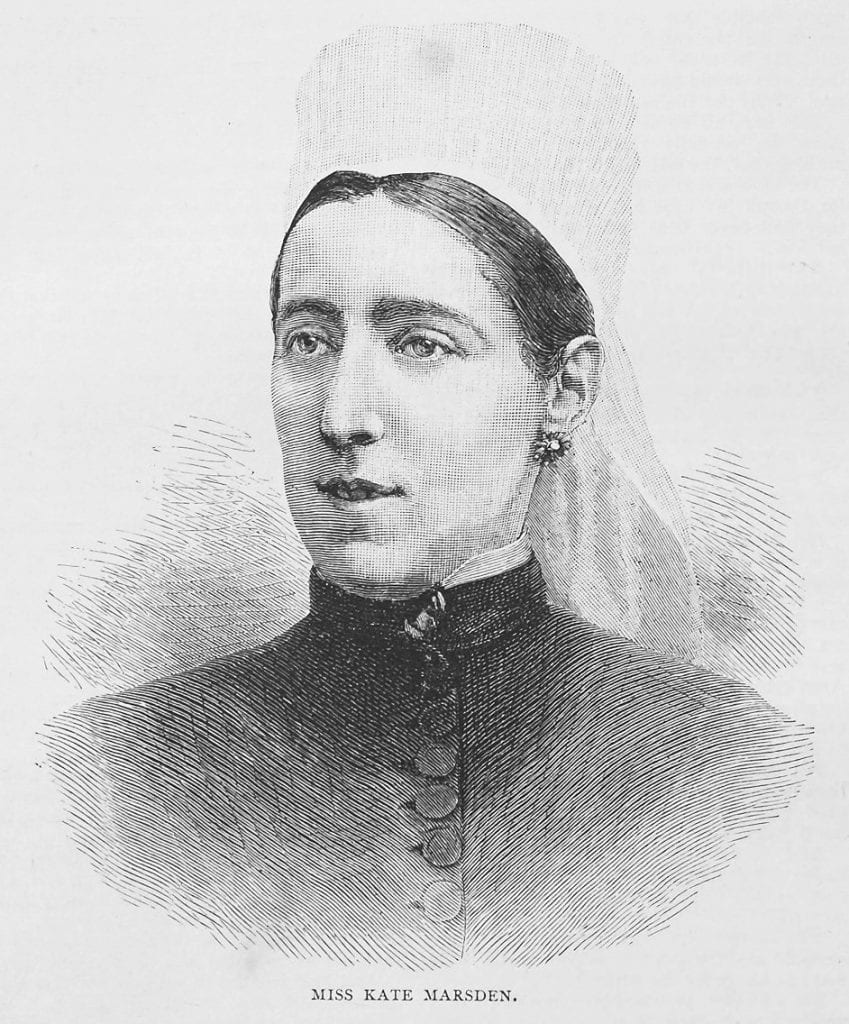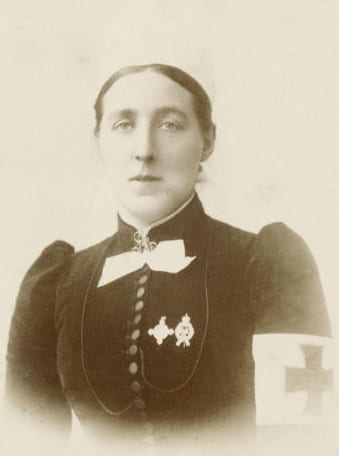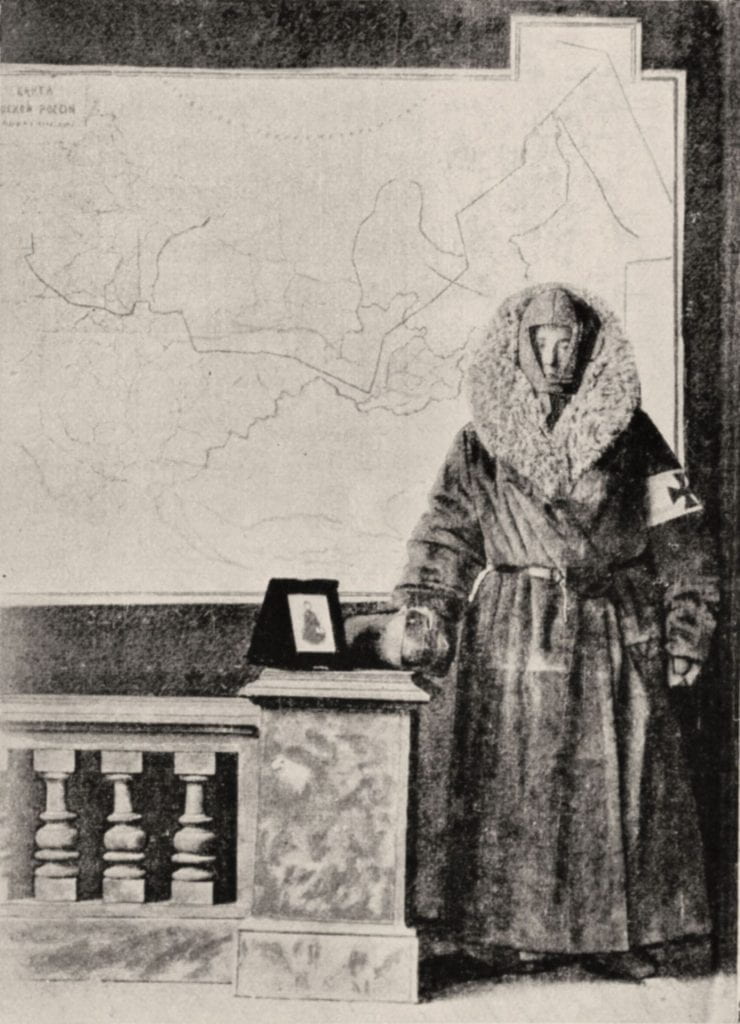By Michele Leggott

It is Wednesday 2 January 1889 and the campers at Happy Valley have just two more nights to enjoy themselves under the stars before heading back to Nelson and the start of another working year. Emily Harris records the moment in her diary:
Our concert this evening was better as we had Mr Kempthorne. Before it commenced Miss Marsden told us some of her experiences as one of eleven Red Cross Sisters who were with the Russian Army when fighting with the Turks. Most thrilling & ghastly stories coming from an eye witness and participator affect one in a way that no printed records ever can. Thursday. In the morning Miss Marsden drove into town & took Mrs Washbourn with her. I went ferning with Mr Kempthorne, he having offered to take the plants into town with him. In the afternoon the Cable Bay young men sent a buggy for some of the young ladies & Mrs Wright, to go to Cable Bay for tennis & afternoon tea. Frances & I went on with our sketches.
The Rev John Pratt Kempthorne’s fine singing voice enhanced the Wednesday night camp concert. Emily had observed that Miss Marsden was to drive out to the camp in her pony carriage in the wake of the horse-drawn omnibus and wagon that transported the campers and their luggage from Nelson to Happy Valley Thursday 27 December 1888. But who was Miss Marsden, eye-witness to thrilling events of the 1877-78 Russo-Turkish war? It didn’t take long to discover her in New Zealand papers of the day:
The Colonial Secretary has, on the recommendation of Dr. Grabham (Inspector of Hospitals), appointed Miss Kate Marsden to the position of Lady Superintendent of the Wellington Hospital, vacant by the retirement of Mrs. Kissling. Miss Marsden is a young lady aged 26, who recently arrived in Auckland from England, and possesses the highest testimonials of qualification for the office to which she has been appointed. She was trained at the London Evangelical Deaconesses’ Institution at Tottenham and at the Westminster Hospital. She served as a nurse in the Institute’s detachment during the Russo-Turkish war, and was four months in Bulgaria at that time. She has since filled the position of assistant superintendent of the Woolton Convalescent Institution, and on resigning that office was the recipient of a very handsome present and testimonial from the authorities and officers. (Evening Post 1 Apr 1885: 3)

Then we discovered that Kate Marsden has a Wikipedia page. A moment or two later we found researcher Kate Marsden (no relation) and her website Kate Marsden: Victorian Explorer Extraordinaire and realised that the camping trip in Nelson was part of a prelude to (yes) extraordinary adventures and sustained doubt as to their (and her) credibility. The opening page of Kate Marsden’s website about KM lays out the parameters:
Kate Marsden was a Victorian nurse who, in 1891, trekked thousands of miles across Russia to help Siberian leprosy sufferers.
On her return, she became one of the first women to be elected a Fellow of the Royal Geographical Society, and for a while was feted for her adventures and able to raise significant funds to aid the plight of the lepers.
But people took against her; the veracity of her journey was called into disrepute, as well as her management of the funds she was raising, and as a result of a smear campaign led by American translator Isabel Hapgood, KM was unable to ever really restore her reputation or succeed at any other philanthropic projects she initiated. She died in 1931 and was buried in an unmarked grave.
I have been interested in KM, as my namesake (though we are not related), since the 1980’s, after being given a copy of her travel account On Sledge and Horseback to Outcast Siberian Lepers. I’ve travelled to Siberia twice, read hundreds of newspaper articles, and transcribed over 250,000 words from letters written at the time. My aim is, eventually, to write a book that successfully conveys the triumphs and tragedies of KM’s extraordinary life. You can read more about my research here (including why most of the content on this blog is currently inaccessible).
One of the unexpected joys from this process has been meeting and connecting other people interested in KM. If you’re one of these (whether an academic, explorer or just someone curious), do get in touch. I’d love to hear from you.
So we did, and sent along a transcript of the section of Emily’s diary in which Kate Marsden makes her appearance. We saw from the website timeline that KM arrived in New Zealand with her mother and tubercular sister Annie early in 1885. Annie Marsden died within a month of arrival in Auckland, Kate was appointed lady superintendent of Wellington Hospital in April. She suffered an accident at work that forced her to resign the position in September, after which she and her mother traveled to Nelson so that Kate could recuperate. Researcher Kate Marsden has assembled a wealth of names associated with KM’s visits to Nelson 1885-89, but Emily Harris is not among them. The fortuitous mention of KM in Emily’s diary is one of those conjunctions that pushes research along (‘I always thought there must be mentions of her in various diaries or letters,’ Kate told us in her email).
What went wrong for missionary and nurse Kate Marsden? A quick trawl of Kate’s website uncovered a trail of second opinions and snide editorial remarks in New Zealand papers in the wake of Isabel Hapgood’s expose of KM’s leprosy mission in Siberia. One sample:
Miss Kate Marsden, who recently received from the Queen a decoration in the form of a gold brooch of the figure of the Angel of Victory, engraved with the words “Victoria R.I.,” is one of the cleverest humbugs of the day. She has been taken up by Royalty, is on terms of friendship and intimacy with the great ones of the earth, and has had honours showered upon her for what has been described as “her devoted work among the lepers of Siberia.”
But what Miss Marsden has really done for the lepers of Siberia or the lepers of anywhere else we have never been able to discover. She has doubtless travelled sufficiently to be able to tell “yarns” about them but those who remember her little stories of her adventures in New Zealand will be inclined to discount pretty largely anything that comes from her lips or pen. Miss Marsden enjoys travelling, in first-class style and at other people’s expense, and as long as she can manage to throw a glamour over wealthy ladies with sympathetic hearts just so long will she continue her truly royal marches in various parts of the world. It is strange that Miss Marsden has not been found out and the selfishness of her so-called philanthropic schemes exposed before this.
From the time when she commenced her mission of gaining her livelihood by working upon the sympathies of wealthy people, she has gone onward and upward in her own importance and in the estimation of distinguished people. If the eyes of one or two of her friends have been opened and she has been dropped by them, she has been able to capture other and bigger game, in the shape of even wealthier and more distinguished supporters. Miss Marsden does not aim at winning kindly-hearted but soft-headed people. She goes straight for ladies in the front rank – clever, distinguished, philanthropic, wealthy; and she succeeds.
If, for instance, Miss Marsden were not so well known in New Zealand, how could we, any of us, doubt her bona fides after reading the following paragraph about her in the Home papers: “At Lady Jeune’s house in Harley-street (London), Miss Kate Marsden gave a detailed and interesting account of her work among the lepers of Siberia. Among those present were the Duchess of Teck and Princess May, the former, who takes a great interest in Miss Marsden’s charitable regard for a neglected class of sufferers, asking many questions calculated to throw light upon the condition of these unfortunate creatures. The main object of Miss Marsden’s address was, if possible, to collect £300 for the publication in America of her forthcoming book, the profits of which she generously intends to use in her scheme of mercy. The Nursing Record has undertaken to provide the funds for the English edition, and surely across the seas there are those who will find the comparatively small sum necessary. Lord Meath, Mr Knowles, and Mr and Mrs Frank Harris listened to the admirable address of Miss Marsden and to the supporting eloquence of Surgeon-Major Pringle and Sir Douglas Galton. Miss Marsden sails on Saturday for the United States, where her welcome must be assured.
The Nursing Record states that on October 28th Miss Marsden received the special silver badge of the Nurses’ Institute, which was pinned upon her breast by Princess Christian; while, according to other papers, she was the guest of the Queen at Balmoral a few days later, and her farewell meeting was attended by members of the Royal Family. Our New Zealand newspapers do not seem to be impressed with the distinction Miss Marsden has gained, neither are they inclined to go into extacies over anything she has done or is ever likely to do on behalf of the lepers or anybody else besides herself.
There is a wealth of quiet satire in the following reference to her projected book, which we cull from the Christchurch Press:- “Miss Marsden has written a book on her experiences, which we may safely predict will be full of the most graphic and surprising details. Her zeal for lepers continues quite unabated, and at latest advices she was meditating a journey to America to see whether there were any to be discovered in that country and incidentally to collect funds for their benefit.”
Miss Marsden has some friends in New Zealand who, if they were only to join together to write a book, giving the simple facts of how she “had” them, would be able to produce a volume quite as marvellous and much more interesting than Miss Marsden’s collection of tall “yarns”. (Wanganui Chronicle 19 Dec 1892: 2)
Researcher Kate Marsden forwarded several pages of KM’s 1895 biography, A Life of Kate Marsden, by Henry Johnson. She notes KM’s account of meeting Kuia Julia Martin, who invited her to a feast in her honour among her own people. Julia Martin, described by KM as ‘living some distance from Nelson’ (p. 20) is one of the proprietors of the land leased to farmer George Sinclair at Happy Valley. It is the proximity of KM’s recollection of Julia Martin and a certain camping trip that heightens the possibility we are looking at a morphed but recognisable version of Emily Harris’s camping out at New Year 1888-89. Johnson paraphrases and then quotes KM:
The unconventional way of holiday-making in New Zealand was a matter of considerable enjoyment to Miss Marsden. A party of about twelve, including Miss Marsden, once planned a fortnight’s outing, The ladies arranged to provide the food, and the gentlemen the tents. The latter went on in advance to choose a suitable place in the bush, where protection could be got from the sun by day and from the damp by night. They pitched the tents, cut down ferns, sufficient to make beds for all the company, and chopped wood for cooking purposes. Then the ladies and children set off from Nelson, some in carts and some in carriages. The fortnight was spent in delightful rambles among the ferns and flowers, in boating, fishing, and hunting. After the daily adventures the party gathered round the fire, to exchange experiences, tell ghost stories, and to sing songs of Motherland.
The mosquitoes were a little troublesome, it is true but they were the only trifle to interfere with the constant round of healthy enjoyment.÷
This “going right away from everybody and everything,” as Miss Marsden terms the holiday, this freedom from all worries, and the excitements of town life, with nothing but pure air and the beauties of nature around, was a tonic for the health, the spirits, and the mind, which Miss Marsden felt would arouse the envy of her friends at home. (p. 23)
Kate Marsden’s list of some of those KM associated with in Nelson and Wellington may ring bells for local researchers:
- Miss Edith Brown
- Jessy Brodie (widow, her photo is in the Nelson collection as well, taken at the same time as KM’s)
- Mrs Ellen Duff Hewett (widow, Wellington area, eventually)
- Mrs Ellinor Hunter-Brown (Nelson)
- Misses Ellen & Annie Greenwood (in Wellington)
- Mrs Helen Snow (Wellington)
Photos of Kate Marsden in Nelson show up in the Tyree Studio Collection in the Nelson Provincial Museum where we can find four striking photos of her (Refs. 31855, 31856, 31857, and 31982) before she continued her adventures abroad.

Kate Marsden in full travelling dress with a map of her route through Siberia. Published in On Sledge and Horseback to Outcast Siberian Lepers (1892).
Lead writer: Michele Leggott
Research Support: Brianna Vincent
Lovely to see this! Hope it helps unearth other research.
Kate
Thank you! It’s been so much fun looking at Kate Marsden, and thank you so much for your help!
Very interesting – I hadn’t come across mention of this indomitable woman before.
Re Ellen (1837-1917) and Ann (Annie) Greenwood (1845-1925), on KM’s list. Both were daughters of Nelson & Motueka pioneers and leading citizens, Dr Danford & Sarah Greenwood. The Greenwoods played a prominent part in local social life and shared a deep committment to the Anglican Church. Dr Greenwood had close connections with Wellington through his political activities.
http://www.theprow.org.nz/people/sarah-and-john-danforth-greenwood/#.XrNmdq2B2Cc
Ellen spent 8 years as governess to Sir Thomas Gore-Browne at Government House, Auckland, and in Tasmania, while another sister, Mary, acted as governess to the children of Colonel Haultain, politician and Minister of Colonial Defence from 1865-69. All three sisters had previously assisted their mother in running a school for girls in Nelson known as “Woodland House”.
Ellen and Ann joined Mary in Wellington around 1868 where together they ran schools for girls (both boarders and day pupils) and were also connected with a number of charitable organisations. None of them ever married. Mary, described as “a tireless social worker”, was a founding member of the “Wellington Ladies’ Christian Association”, while Ellen established the “Alexandra Home” for unmarried mothers and the “Levin Memorial Home” for young girls. Ann’s role was mostly as a support person – she acted as housekeeper and matron for the boarders.